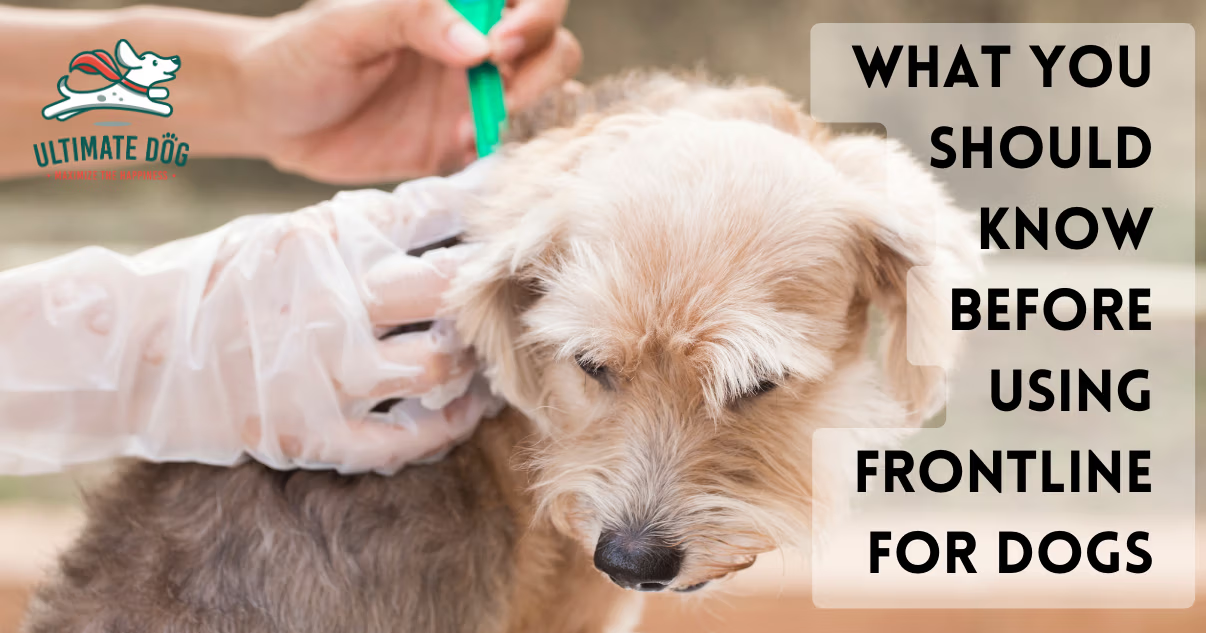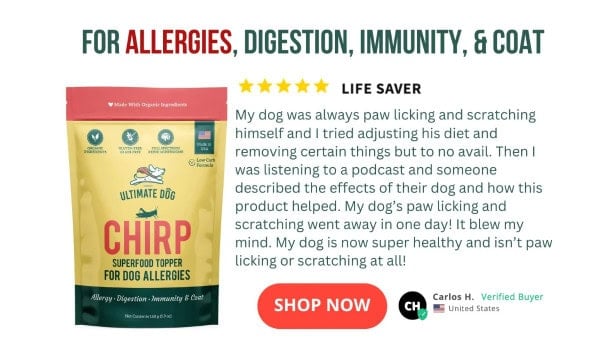Frontline flea and tick protection for dogs is one of the most popular topical drugs used by pet parents to help keep their dogs pest free. But many owners—and veterinarians—have voiced concerns about the safety of Frontline’s products.
While the makers of Frontline insist that there are few side effects associated with this drug, a deeper look at its ingredients and research into its use tells a different story.
Below, we look at what Frontline for dogs is, how it works, and what the active ingredients in these topical products are. Most importantly, we discuss how these ingredients interact with the body and why those interactions pose a risk not just to your dog, but to those who come into contact with them. Lastly, we’ll look at some safe natural alternatives to controlling fleas and ticks that are a better option for everyone.
What Is Frontline for Dogs?
Frontline is a tick and flea preventative for dogs. The company, which is owned by Merial, a subsidiary of Sanofi, has a number of products available, including topical and oral medications. Frontline Plus, which is a once-monthly topical treatment, is the most popular product and the one we will focus on in this article.
How Does Frontline Work?
Frontline Plus is applied on the skin between the dog’s shoulder blades. It must be applied here because it is toxic if ingested and must be placed in a location the dog is unlikely to be able to lick.
Once on the skin, the drug is absorbed and stored in your dog’s sebaceous glands. These tiny glands are present all over dogs’ skin and are responsible for secreting oils into hair follicles to lubricate the skin and coat.
Twenty-four hours after application, the concentration of Frontline on your dog’s coat is at its highest. From there, the concentration will slowly drop for about five weeks until it is no longer detectable. The company recommends reapplying the treatment every month.
The active ingredients in Frontline target the life cycle of fleas and ticks to kill both the adult and larval stages of the parasites. Because the chemicals coat the dog’s hair and kill insects on contact, the pests do not have to bite the dog to be killed by Frontline.
Active Ingredients
Like many other tick and flea medications for dogs, Frontline Plus utilizes two insecticides to kill parasites, S-methoprene and fipronil.
S-methoprene
S-methoprene is a chemical that mimics the action of an important insect growth regulator hormone. It is widely used in insecticides, livestock feed, and topical bug sprays because it has the potential to kill insects that other insecticidal chemicals are ineffective against. By mimicking natural methoprene, this chemical prevents flea and tick eggs from hatching, larvae from growing, and adults from reproducing.
Toxicity from overexposure to s-methoprene can cause severe skin irritation and itching, vomiting, diarrhea, dilated pupils, behavior changes, and motor impairment. But, compared to the other active ingredient in Frontline, this one is generally well tolerated and does not produce many side effects.
Fipronil
Fipronil is the more potent active ingredient in Frontline. This chemical attacks the central nervous system, effectively killing insects that eat it or come into contact with it. It is a widely used insecticide and is present in many products, from lawn treatments to ant baits.
This chemical is more likely to bind to nerve endings in insects than in mammals but is known to affect many animals including dogs and humans. Fipronil can produce toxic effects on the liver, kidneys, and other organs. It has inhibitory effects on the mitochondrial respiratory chain, negatively affects calcium homeostasis within cells, and can cause oxidative and nitrosative stress to the body. It is also known to cause damage to DNA and proteins within cells.
Fipronil can cause skin irritation, nausea, vomiting, weakness, ataxia, aggression, and convulsions. Severe side effects are most likely when the drug is given at high doses and when ingested. More concerning is fipronil-sulfone, a common metabolite of fipronil that is formed in the body even when fipronil is given topically at low doses.
Fipronil-Sulfone
When fipronil is applied to the skin, some of the chemical is absorbed into the cells and metabolized into fipronil-sulfone.
Compared to fipronil, fipronil-sulfone has a ten-fold greater selectivity for the mammalian nervous system. If absorbed in high enough quantities, it can cause a range of problems from seizures to death.
In lab tests for Frontline, the amount of this byproduct created was too low to cause problems. However, the hydrolysis of fipronil is highly dependent on temperature and skin pH. How much of this chemical is converted into dangerous fipronil-sulfone depends on the external environment, breed of dog, and the dog’s skin and overall health.
Many vets have reported severe neurological reactions to Frontline in pets they’ve treated. Fipronil-sulfone is the likely cause of these unpredictable responses. While the lab environment may keep levels of this metabolite low, real-life environments appear to occasionally produce enough of the byproduct to cause toxic consequences.
Known Side Effects of Frontline
According to the manufacturers, Frontline Plus has minimal side effects . However, it is worth noting that most of the research done to back these claims was conducted in highly controlled environments using only one breed of dog (beagles).
In larger, field-type trials, many participants have suffered notable side effects. The most common is irritation and itching at the sight application. Some go on to develop lasting hair loss between their shoulders. Nervous system disorders, seizures, and death have also been seen in these types of trials.
Interestingly, Frontline is deadly when used on rabbits and guinea pigs. It is also more likely to cause severe side effects in small breeds of dogs compared to large breeds. According to the cautions on the packaging, the product should not be used on dogs under 8 weeks of age, debilitated animals, elderly dogs, or pregnant or lactating dogs.
Also worth noting, in many field-type studies, a number of participant dogs died due to tick-borne illness. This would indicate that Frontline is not completely effective in preventing tick bites, calling into question not just the safety of the product, but also its efficacy.
Not Just Pets
But your dog isn’t the only one who has to worry about the potential side effects of flea and tick prevention. Because of how these products work, the active chemicals in them are present on the dog’s fur for weeks after application. That means anyone who pets the dog will end up with these nasty chemicals on their skin. For children who often put their hands in their mouths, this is especially worrisome since ingesting fipronil is far more toxic than simple skin contact.
Fipronil is considered a “possible human carcinogen” by the EPA and has been shown to cause thyroid tumors in rats.
But the toxic reach of fipronil goes beyond the household. High levels of the chemical have been found in the wastewater of homes that use flea and tick prevention on their pets. Concentrations at many water treatment facilities tested have been found to exceed USEPA Aquatic Life Benchmarks. Both fipronil and its byproducts are highly toxic to fish, aquatic invertebrates, and many species of birds.
Natural Alternatives to Control Fleas and Ticks
For many dogs, Frontline causes skin irritation and hair loss that grows worse with repeated use. And for some, the side effects can be severe and life threatening. Even more concerning, due to the way Frontline works, its negative effects are not limited to your dog; this drug can harm your family and the environment, as well.
Rather than risk using Frontline, we recommend opting for a safe, natural, and effective alternative to control fleas and ticks on dogs. Here, you have many options.
Diatomaceous Earth
One of the most effective natural preventatives and treatments for ticks and fleas on dogs is diatomaceous earth (DE).
DE is a natural white powder made from crushed-up fossilized diatom shells. These tiny shells are high in silica and sharp enough to penetrate the protective exoskeleton of small insects. When exposed to DE, fleas and ticks dehydrate to death in a matter of hours. Food grade DE is safe for people and pets, and aside from drying out the skin if overused, has no side effects.
Best of all, DE can be used to prevent fleas on dogs as well as to treat active flea infestations. It is also effective against ticks, but, because it doesn’t kill right away, can still leave your dog vulnerable to bites.
This topical treatment is best for focused uses, such as after fleas are discovered or before you visit a place known to harbor fleas.
Garlic
For preventing ticks on dogs, garlic is a great option. When fed consistently. Garlic odor seeps through the skin repelling insects, including fleas, mosquitoes, ticks, and flies. While many owners are told garlic is toxic to dogs, the truth is it is quite safe at low doses. Pairing garlic with vitamin B complex (such as what is found in brewers yeast) seems to increase its effectiveness. This combination also has the benefit of supporting skin health, which in itself, helps protect against parasite infestations.
Essential Oil Sprays
Just as many people rely on natural bug sprays to protect themselves from biting insects, so too can your pet. Natural essential oil bug sprays for dogs can help protect against ticks and fleas. You have to be consistent about applying them, of course, but they are far safer and some are just as effective as the chemical alternatives.
Warm Soapy Baths
There are a lot of flea shampoos out there. Many of them utilize the same toxic ingredients that Frontline does. But the truth is, any shampoo that creates a lather is effective at killing fleas.
Soaps dissolve the oily layer on flea and tick exoskeletons and cause the bugs to dehydrate to death. If your pup has an active flea infestation, all they need is a good, sudsy bath with gentle, natural shampoo to take care of it. Using a flea comb to brush them out after can help remove dead dying fleas and eggs to prevent re-infestation.
Soapy baths are also a great option for dogs returning from camping trips and hikes where ticks may have been encountered. Give the bath as soon as you can to target ticks before they have a chance to bite.
Maintain a Healthy Skin and Coat
The best offense against parasites is a good defense. For dogs, that starts with a healthy skin and coat. Healthy skin is better able to defend against fleas and less likely to be targeted by fleas and ticks.
You can help ensure your dog’s coat and skin are healthy enough to fight back by feeding a high-protein, biologically appropriate diet, utilizing a quality probiotic supplement with digestive enzymes, and avoiding products that irritate and damage the skin. And yes, Frontline would be considered one of these irritating products to avoid.
The Bottom Line on Frontline
Frontline is a fairly effective flea and tick preventative for dogs, but it isn’t without its safety concerns and side effects. And these aren’t just limited to your pooch. Because insecticides like fipronil and s-methoprene are excreted by the skin when dogs are treated with Frontline, these chemicals have the potential to get on your family and into your water supply.
Rather than take a chance on a product with known problems, we recommend opting for natural flea and tick prevention instead. There are many effective options in this category. But the first step to keeping your dog safe from external parasites is to provide a high-quality diet and skin-supporting supplements.
Sources
Australian Pesticides and Veterinary Medicines Authority. (n.d.). Safety of Fipronil in Dogs and Cats: a review of literature. https://johnsonvet.com/. Retrieved May 31, 2023.
Fipronil General Fact Sheet. (n.d.). National Pesticide Information Center.
Gupta, R. C., & Anadón, A. (2018). Fipronil. In Elsevier eBooks (pp. 533–538).
Gupta, R. C., & Doss, R. B. (2023, June 2). Phenylpyrazole (Fipronil) Toxicosis in Animals. MSD Veterinary Manual.
Ka, J., Canerdy, T. D., Rj, K., Atieh, B. H., Doss, R. B., & Gupta, R. (2002). Human exposure to fipronil from dogs treated with frontline. PubMed, 44(5), 301–303.
Methoprene General Fact Sheet. (n.d.). National Pesticide Information Center.
Rohdich, N., Roepke, R. K. A., & Zschiesche, E. (2014). A randomized, blinded, controlled and multi-centered field study comparing the efficacy and safety of BravectoTM (fluralaner) against FrontlineTM (fipronil) in flea- and tick-infested dogs. Parasites & Vectors, 7(1), 83.
Teerlink, J., Hernandez, J., & Budd, R. D. (2017). Fipronil washoff to municipal wastewater from dogs treated with spot-on products. Science of the Total Environment, 599–600, 960–966.

Sara Seitz worked in the pet industry for over a decade. In addition to being a certified dog trainer, Sara gained experience working as the general manager of a dog daycare and boarding facility, as the creator and manager of a pet sitting company, as a groomer, and as a dog behavior evaluator. She also has a bachelors in animal behavior from CSU. Currently, Sara works as a freelance writer specializing in blog, article and content writing.




Leave a Comment